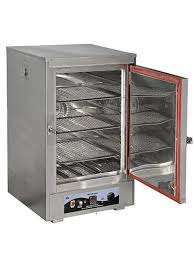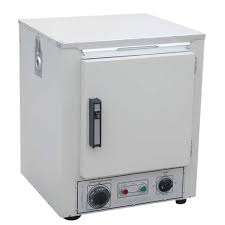

HOT AIR OVEN
They do not require water and there is not much pressure build up within the oven, unlike an autoclave, making them safer to work with. This also makes them more suitable to be used in a laboratory environment. They are much smaller than autoclaves but can still be as effective. They can be more rapid than an autoclave and higher temperatures can be reached compared to other means. As they use dry heat instead of moist heat, some pathogens like prions, may not be killed by them every time, based on the principle of thermal inactivation by oxidation.
A Hot Air Oven is a specialized sterilization device that operates using dry heat to sterilize various materials, particularly those that cannot withstand moisture. Unlike steam-based sterilization methods, which use high-pressure steam, the Hot Air Oven relies on heated air circulated within a sealed chamber to eliminate microorganisms, including bacteria, viruses, fungi, and spores. This dry heat method works by oxidizing cellular components and denaturing proteins, effectively rendering harmful organisms inactive.
A Hot Air Oven is a specialized sterilization device that operates using dry heat to sterilize various materials, particularly those that cannot withstand moisture. Unlike steam-based sterilization methods, which use high-pressure steam, the Hot Air Oven relies on heated air circulated within a sealed chamber to eliminate microorganisms, including bacteria, viruses, fungi, and spores. This dry heat method works by oxidizing cellular components and denaturing proteins, effectively rendering harmful organisms inactive.
The oven typically operates within a temperature range of 160°C to 180°C, with sterilization times adjusted according to the specific temperature and nature of the items being sterilized. For example, sterilizing at 160°C may require about two hours, whereas at 170°C, the process might only take one hour. The ability to use different time-temperature combinations offers flexibility in ensuring thorough sterilization based on the material and load.
Features
- Temperature Control: Accurate temperature settings within 160°C to 180°C.
- Chamber Size: Adequate capacity for your sterilization needs.
- Heat Distribution: Even air circulation for consistent sterilization.
- Energy Efficiency: Well-insulated design to reduce energy use.
- Safety Features: Overheat protection and alarms for safe operation.
- Build Quality: Ensure the oven is constructed from durable, heat-resistant materials for longevity.
- Ease of Maintenance: Choose an oven that’s easy to clean and maintain, with accessible components.
- Warranty and Support: Check for a good warranty and reliable customer support for peace of mind.

